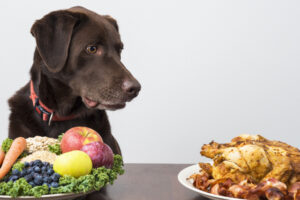We often get asked, “What is a good dog food?” Or, “how do I choose a dog food?” We’ll try to help with this very brief article.
First, you have to realize that the dog food industry is a huge marketing endeavor. Millions of dollars are poured into TV and magazine ads that pull at the dog owner’s emotions. You see the little dog running towards his/her food bowl (I’d run towards my plate too if I hadn’t eaten in two days prior to the commercial). We see dogs jumping, playing with family, all this energetic activity to promote the protein within a particular dog food. So the first thing you to understand as a dog owner is that a TON of marketing strategy is being invested towards YOU. They couldn’t care less. He can eat poop (his or another animal’s) and be perfectly content – at least as far as that snack can take him. Brightly colored foods are directed towards YOU, not the dog. Pretty pictures on the dog food bag are for YOU, not the dog.

Second, dogs are carnivores. They are primarily meat eaters. In the wild, they do eat some berries and ingest other plants through the intestinal system of the animal they are eating that day. In order to provide a food source that is consistent with the dog’s stomach and digestive system, meat will need to be the majority of his food source. Dogs do not naturally eat corn, soybeans, or wheat gluten. Corn and soy are fillers. Stay away from these in dog foods, as well as by-products (a cheap source of protein and glucosamine).
Third, pay close attention to the ingredient list of the dog food you choose. The first three ingredients form the vast majority of the contents. These should at least include two quality meat sources and maybe a quality vegetable. Ignore the marketing that goes along with the brand – pay attention to the ingredients. Your dog won’t be eating a million-dollar TV commercial; he’ll be eating the ingredients in his food.
Fourth, stick with a dog food that is made from quality whole grains, not grain-free or cheap grains (like corn and soybean). Cheap grains in dog foods can cause allergies and many other health issues. You may save a few bucks on the food but pay out the nose for the vet bills this lackluster food causes. You will save far more time, money, and emotion by purchasing a quality food in the first place, not to mention possibly saving your dog a lot of pain and aggravation. There are serious concerns about grain-free food – full of starches like peas, potatoes, and legumes – causing dilated cardiomyopathy (DCM). DCM is a heart disease that can lead to congestive heart failure.
Fifth, quality foods produce less stool/feces. This means that more of the ingredients are being absorbed by the dog instead of pooped onto the ground. Cheap foods will require more volume to satisfy the dog’s hunger and nutritional needs. For example, a large dog on a cheap food may need 6 cups per day. The same dog who is fed a quality food may only need 3 cups per day. So you use less, waste less, and spend no more (and maybe less in the long run) on a quality food than you would a cheaper, grain-filled brand. Furthermore, your dog will be healthier, feel better, and not over-work his digestive system when using a quality food – the same price or less than purchasing a cheap brand. Using a quality food is a no-brainer!
Also, there is strong support for a raw diet. A raw diet is not for everyone. The biggest thing to consider when feeding a raw diet is to keep things balanced and be sure the dog is still receiving the vitamins and minerals he needs. For most people, this is far too much work and research. But those who can make the extra effort will be pleased with the results.
Fortunately, dog food chains have increased their quality is recent years. This is due largely to the demands of dog owners for better food and to the education of dog owners on the subject.
We realize that this article is not exhaustive. It is beyond the scope of this blog to answer all questions about dog foods. There is MUCH MORE that could be said concerning this subject. In fact, trainers in our Dog Trainer College spend a good deal of time learning the ins and outs of canine nutrition. But if you will utilize the principles outlined in this little article, you will make a positive difference in your dog’s consumption and probably his/her overall health.

